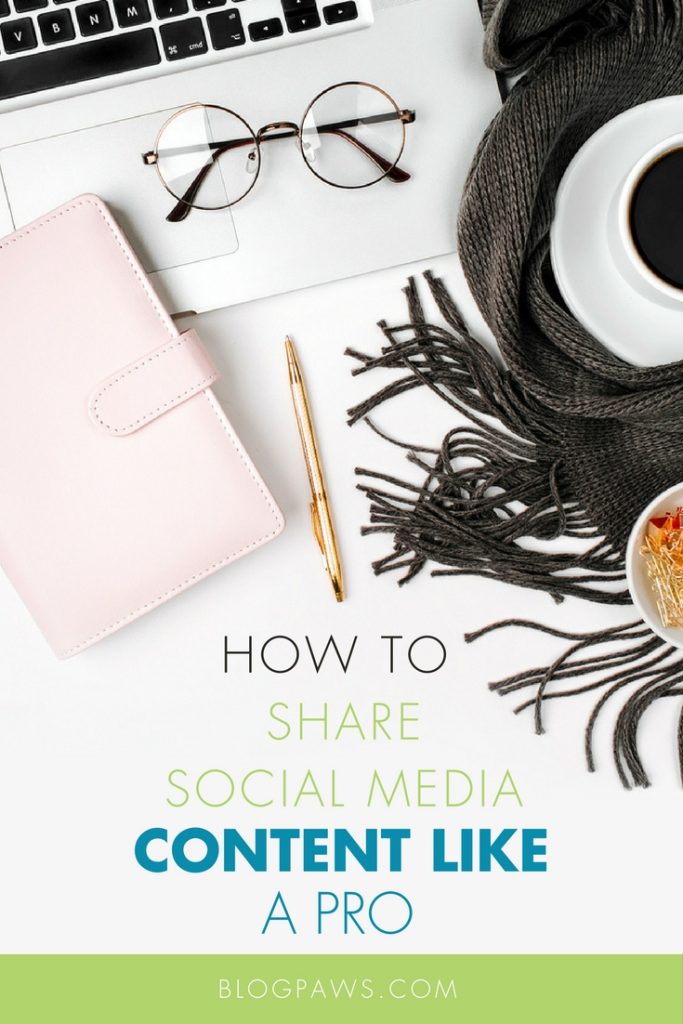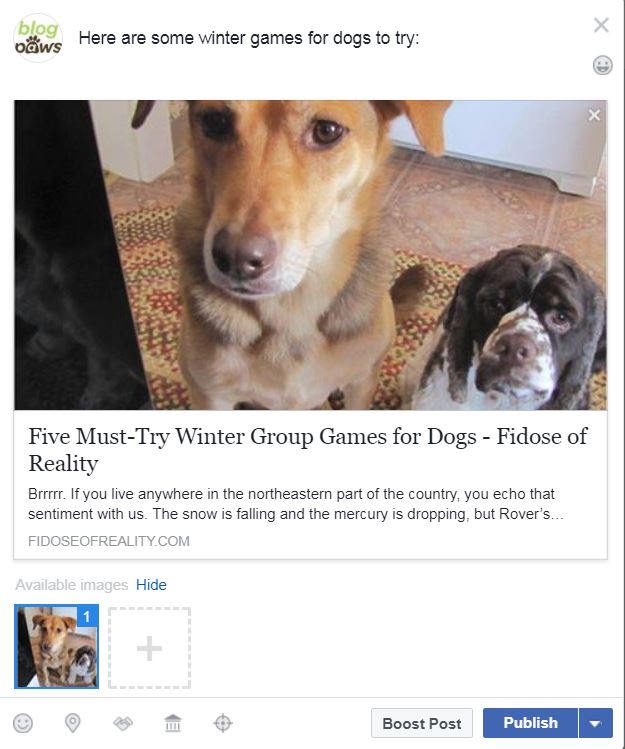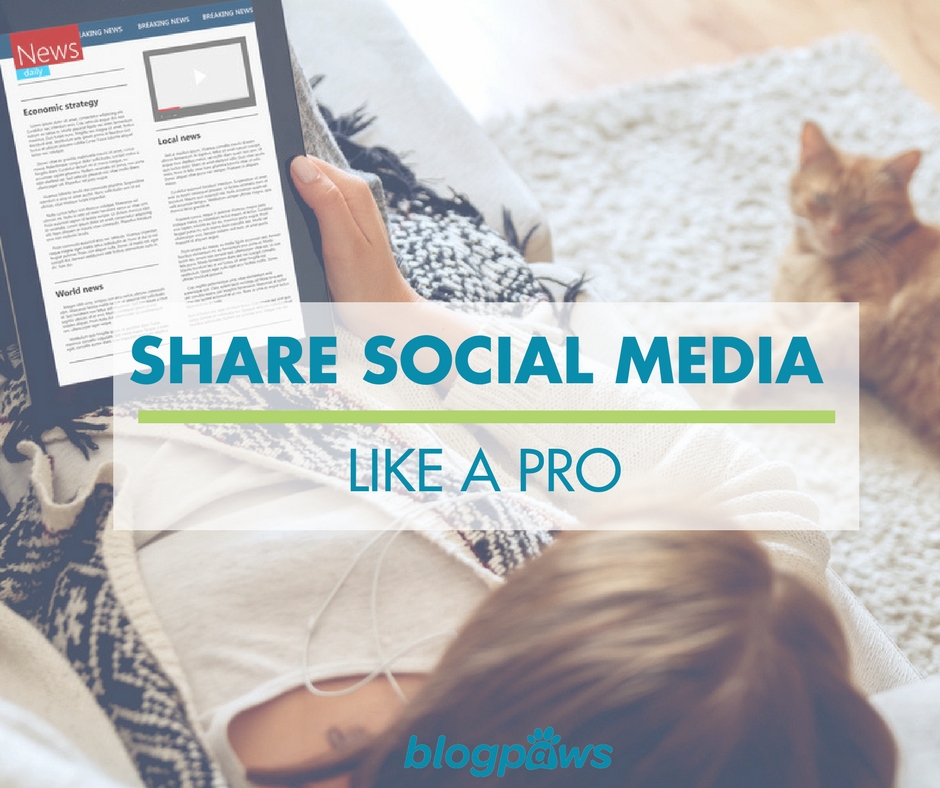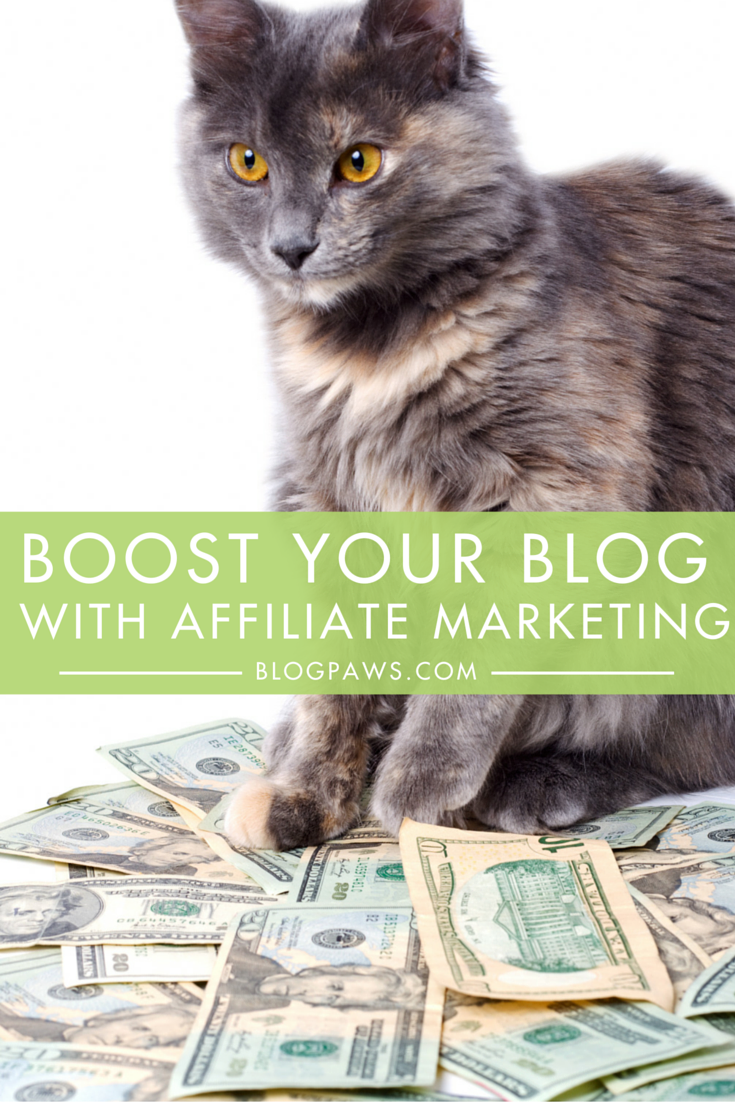How to Share Social Media Content Like a Pro
What does your social media content say about you? If a picture says a thousand words, then knowing how to properly share social media content is pivotal in these ever-changing times. If you work with brands on social media content, the appearance and format of social media updates is crucial. Here is a step-by-step guide to walk you through social media content sharing like a pro.

The Importance of Images
Facebook will pull in through its API a default image from your blog post. You want to be sure the image that gets pulled is the one you want there, especially when working on a paid campaign for a brand. For example, here’s a blog post that I uploaded to BlogPaws’ Faebook page. Take a look to see if anything seems amiss:

The dog on the left is cut off and you do not want to have that appear that way on Facebook. The same thing holds true for campaigns. Before you hit publish, look at your image. Is it a blaring advertorial? Is the image representative of your blog post? Are any animals cut off? Does the image catch the reader’s eye, which in these hectic times doesn’t stay for long?! If not, you need to be sure the image that Facebook pulls is the one you want there. Alternatively, you can upload your own image.
The folks over at Sprout Social have an up-to-date guide of image sizes to access. Remember, you do not want to stretch a photo, but ensure that it fits in the properly sized template.
Call to Action
We talk an awful lot about call to action here at BlogPaws. That’s because a quality, concise CTA is essential for click through.
A Call to Action is a statement that encourages your readers to take some sort of action. In a sponsored blog post, this may be clicking a link to a website or product landing page, or it may be to ask your readers to share information to help increase awareness of the brand, product, service or initiative, among others.
For non-sponsored posts, your CTA may be to sign up for your mailing list in exchange for a free e-book or it may be as simple as to ask your readers to leave a comment or share your blog post on social media. These are just two examples.
The right image with the right call to action complemented with a few dollars to a highly targeted audience can help your content soar on Facebook.
Do’s and Don’ts of Social Media Content
Did you just post something on social media and want people to engage with that content? Start the ball rolling with these do’s and don’ts:
Do
- Do consider incorporating video into your social sharing. With software like Lumen5 and apps like iMovie, anyone can be an amateur videographer who comes across like a pro.
- Do post more than one time on each social media platform. Try different photos on Pinterest. Which performs better? Does a certain CTA get better results on Facebook than another? Trial and error.
- Do consider if you are a good fit for a campaign with a brand before applying. If your dog isn’t into kibble or you don’t feed a certain treat, your audience is likely to know that and will see through it when the post is published.
- Do share without oversharing. You want just right–not one and done and not nonstop posting, either. Post one to two times daily on Facebook if the content is quality. Be concerned with the quality of the content and not the number of times you post. Six to 10 times a day on Twitter is fine if the content is awesome. Even with your blog schedule, don’t fret over frequency: Know what you can handle and what makes sense for you.
Don’t
- Don’t regurgitate what already appears in the content starter kit. How long do you stick around and read an ad on someone’s blog? No one has time for that. Be authentic.
- Don’t try to build a huge presence on every social media network. There is not enough time for you to excel at all of them. Three to four social platforms that make sense for you is a better plan.
- Don’t repeat the same message over and over and over. Twitter is one social media platform that is more lenient when it comes to multiple shares of the same message because Twitter moves like the superhighway at rush hour. Reword, change image, and forego reposting the same stale message.

Social Media Disclosure
In this exclusive interview with BlogPaws’ Director of Influencer Marketing Felissa Elfenbein, she shares what you need to know to keep the FTC happy, stay compliant, and keep your online presence in proper form: New FTC Guidelines by Social Media Platform.
Fall in Love With Your Audience
Seriously, you’ve got to swoon to the moon and back. If you don’t know your ideal audience/target demographic, posting to social media is like tossing spaghetti at a wall and hoping it sticks. Here’s a primer to find your target audience on social media (do this for each platform, and realize there will be crossover):
- Using Google Analytics to Identify Your Target Audience
- Identify your ideal reader through surveys and research. Poll your audience.
- Buzz Through These Resources to Learn Google Analytics in a Weekend
Once you have a clear picture of who your ideal customers are, you can use this information to determine where they hang out online and then go seek them!
Not all social media channels will work for all purposes—and your audiences might not be active on certain channels, so keep that in mind. If you want to be on Snapchat, for example, but your audience isn’t there, why bother?
One of the key things to come out of an audience/demographic study is this: Your ideal reader may not be who you expected and you can fine tune your blog and social media strategy accordingly.
Put the Social in Social Media
I cannot begin to tell you how many times I see people moaning about lack of engagement on content but they refuse to engage with others to make it happen. If you are that person at a cocktail party who talks up a storm and wonders why no one listens, then it’s time to change. Admitting it is the first step.
For example, for all of the smart marketers and tips online about Pinterest for blog traffic, the most overlooked is the most obvious: Be social. I have a dedicated portion of my day where I engage with social platforms. For Pinterest, here are a few tips to help your pin engagement and clicks:
- Pin quality content that folks actually care about: Fuzzy, small, pixelated is out.
- Ask yourself if a random stranger would know what the pin is about simply by eyeballing it. A photo of a dog with a bag of food = no; a photo of that dog with the food and the title of your blog post in text overlay consistent with your brand = yes.
- Repin your followers’ pins and comment to let them know you were there.
- Check out your blog and other social media platform comments. Answer those questions and comments in a Pin. If someone asked a cat litter question in your blog comments, it is likely another person has that same question.
Apply these same principles across social media. Yes, absolutely, put social media on a timed planner. Engage, respond, react, act, and be a human in real time.
Your Turn
What are you doing to ensure how you present yourself on social media puts you and your content in the best possible light? What social media pain points can we help you solve? Share in the comments below.
Carol Bryant is the Marketing and Social Media Manager for BlogPaws and runs her own dog blog, Fidose of Reality and its fundraising arm, Wigglebutt Warriors. When not busy playing with her Cocker Spaniel, Dexter, she stays far away from cooking. Her trademark is her mantra and is tattooed on her arm: My Heart Beats Dog.®
Images: Igisheva Maria / perfectlab / Shutterstock.com



